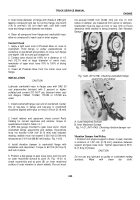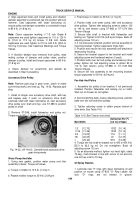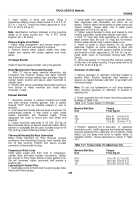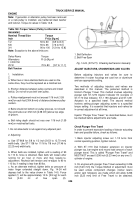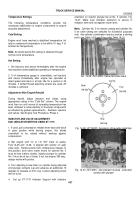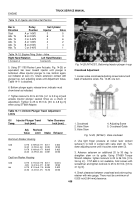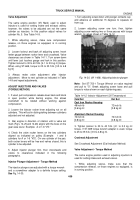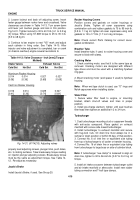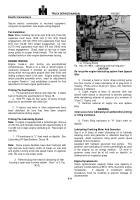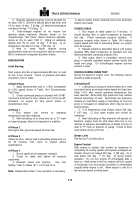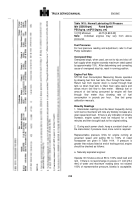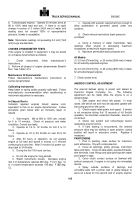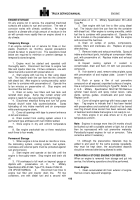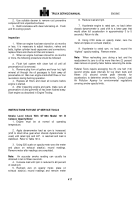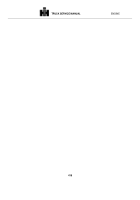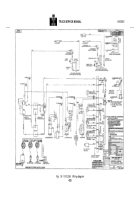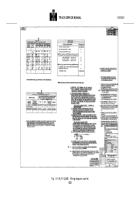TM-5-3805-254-14-P-2 - Page 417 of 894
TRUCK SERVICE MANUAL
ENGINE
3. Naturally aspirated engines must be derated 3%
for each 1000 ft.
[304.8 ml altitude above sea level, and
1% for each 10 deg.
F [6 deg.
C] ambient temperature
rise above 60 deg.
F [16 deg.
C].
4. Turbo-charged engines do not require fuel
derating below maximum altitudes shown in the
"Dynamometer Test Chart." Above maximum altitudes,
derate at 4% for each 1000 ft.
[304,8 ml additional
altitude and 1% for each 10 deg.
F [6 deg.
C] air
temperature rise above 12 deg.
F [52 deg.
C].
5. New
or
newly
rebuilt
engines
during
dynamometer tests are not required to deliver more than
96% of maximum horsepower at power checks.
BREAKIN RUN
Initial Starting
Start engine and idle at approximately 800 rpm no load
for five to ten minutes.
Check oil pressure and water
circulation; look for leaks.
At Each Phase
1. Apply dynamometer load to (+10%) horsepower
at (+5%) speed shown in Table 1414 "Dynamometer
Test Chart".
2. Check crankcase pressure (blowby) with ST487.
If pressure continues to drop, reduce run-in time by half;
otherwise,
run
engine
for
time
period
shown
on
dynamometer chart.
At Phase 1
1. Run
engine
until
normal
oil
operating
temperature has been obtained.
2. Add lubricating oil to bring level up to "H" mark
on bayonet gauge, allow oil temperature to stabilize.
At Phase 2
Set engine Idle, governed speed and fuel rate.
At Phase 3
If blow by rises, reduce load to preceding phase and run
for 30 minutes; then return to original phase
specifications.
At Phase 4
1. Run at speed and horsepower indicated.
2. Check for leaks and tighten all exposed
capscrews.
3. Recheck valves and injectors.
Use "Hot
Setting," refer to Tables 1411, 14.12 and 1413.
Note:
Readjustment after 1 hour operation is necessary
to assure lowest smoke potential and avoid excessive
injector train loads.
POWER CHECK
1. Run engine at rated speed for 5 minutes.
It
should develop 96% of rated horsepower at standard
fuel rate.
Check crankcase pressure (blowby).
If
pressure exceeds value shown in Table 1414 reduce
engine speed and load to preceding phase; run engine
30 to 45 minutes.
2. Repeat procedure described above until engine
develops 96% rated horsepower at standard fuel rate
within permissible crankcase pressure limit.
3. After power check is completed, remove pipe
plugs in naturally aspirated engine cylinder heads and
install vent plugs.
On turbocharged engines connect
aneroid, if used.
CHECKS DURING RUNIN TEST
During the period of engine runin, the following checks
should be made frequently.
Lubricating Oil
1. Lubricating oil pressure should remain at or near
a constant figure at constant engine speed and load (see
Table 1415) after normal operating temperature has
been reached.
Abnormally high pressures may indicate
blocked lubricating oil lines.
Abnormally low pressures
indicate an insufficient supply of lubricating oil from the
pump or increased oil clearances which may be due to
bearing failure.
2. If oil temperature rises sharply above 225 deg.
F [107 deg.
C] shut down engine and correct as
necessary.
3. New lubricating oil filter elements will absorb oil;
therefore, engine must be shut down after five or ten
minutes of operation and additional oil added to bring oil
level to "H" mark on bayonet oil gauge.
Check oil level
every phase during runin test.
Smoke Level
See Service Tool Instructions,
Engine Coolant
After engine is started, add coolant as necessary to
completely fill cooling system and replace entrapped air.
Coolant should not exceed 200 deg.
F [93 deg.
C] or
drop below 160 deg.
F [71 deg.
C] during engine
operation.
Do not turn engine off immediately after a
load run.
Heat stored in the iron masses will boil coolant
in the jackets if air and coolant circulation is immediately
stopped while engine is hot.
Allow engine to idle for a
few minutes before shutting down.
413
Back to Top

